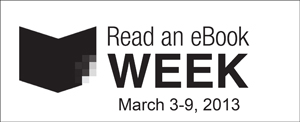It's just a few short weeks till the annual Read an eBook week (March 3-9). This will be the 11th year of the ebook celebration and I encourage everyone to participate (in Canada it is Ebook Month). During that week there will be lots of free books from a variety of great resources- Visit http://www.ebookweek.com/index.html for more information.
As a side note, but one that leads well to the ebook week concept is that this year again I was judging at my regional science fair and noticed some developing trends. Over the last few year the reading science projects included projects such as the can you read with jumbled letters, a wonder study on virus on book covers, and a neat programming project that analyzed text to figure out the author, but this year (2013) there were two studies on ebook devices and reading. One study focused on a single device, with the other used an online textbook, and both were looking at the reading results through assessment. While neither of the studies found significant gains from using the device, it was great to see that they had become part of the K12 student research community.
As a side note, but one that leads well to the ebook week concept is that this year again I was judging at my regional science fair and noticed some developing trends. Over the last few year the reading science projects included projects such as the can you read with jumbled letters, a wonder study on virus on book covers, and a neat programming project that analyzed text to figure out the author, but this year (2013) there were two studies on ebook devices and reading. One study focused on a single device, with the other used an online textbook, and both were looking at the reading results through assessment. While neither of the studies found significant gains from using the device, it was great to see that they had become part of the K12 student research community.



Comments
Post a Comment